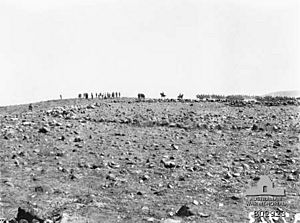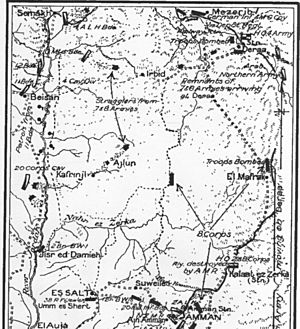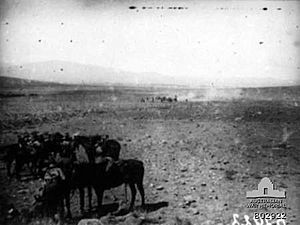Charge at Kaukab facts for kids
Quick facts for kids Charge at Kaukab |
|||||||
|---|---|---|---|---|---|---|---|
| Part of the Middle Eastern theatre of World War I | |||||||
 4th Light Horse Regiment at Kaukab |
|||||||
|
|||||||
| Belligerents | |||||||
| Commanders and leaders | |||||||
| Units involved | |||||||
| Australian Mounted Division Desert Mounted Corps |
2,500 strong force containing remnants of the Tiberias Group a portion of the 24th, 26th and 53rd Divisions and the 3rd Cavalry Division assigned to the defence of Damascus from Yildirim Army Group |
||||||
| Casualties and losses | |||||||
| 72 prisoners | |||||||
The Charge at Kaukab was a quick and important battle that happened on September 30, 1918. It took place near Damascus in Syria during World War I. This event was part of a larger chase by the Desert Mounted Corps after their big win at the Battle of Megiddo.
During this chase, the Australian Mounted Division was riding north towards Damascus. They came across a group of Turkish soldiers who were trying to slow them down. These soldiers were set up on a high ridge at Kaukab. Australian soldiers from the 4th and 12th Light Horse Regiments bravely charged this position. They managed to capture some of the Turkish soldiers, while others ran away.
Why the Battle Happened
After winning the Battle of Sharon and Battle of Nablus, the Allied forces were chasing the Ottoman (Turkish) armies. Many Ottoman soldiers were trying to get to Damascus. They left small groups of soldiers behind to fight and slow down the Allied chase. These groups were found at places like Samakh and Jisr Benat Yakub, which the Australian Mounted Division captured.
Some German and Ottoman soldiers, who had been defeated in earlier battles, gathered at Kaukab. They dug in on high ground on both sides of the main road. This road was important because it led from Jerusalem to Damascus. Their goal was to defend Damascus and stop the Allied advance.
The Chase to Damascus
The chase towards Damascus began on September 26, 1918. The 4th Cavalry Division moved east towards Deraa, which was captured by Feisal's Arab forces. Meanwhile, the Australian Mounted Division started its own chase on September 27. They rode around the northern end of the Sea of Galilee, also known as Lake Tiberias, heading towards Damascus.
By September 26, many German and Ottoman soldiers were retreating towards Damascus. About 6,000 to 7,000 soldiers from different Ottoman armies were trying to escape. Their commander, Liman von Sanders, ordered some of them to go even further north, past Damascus. By September 30, a leading group of the Ottoman Fourth Army was close to Damascus. The 4th Cavalry Division was following them about 30 miles (48 km) behind.
Australian Mounted Division's Role
The Australian Mounted Division had already played a big part in earlier battles. The 3rd Light Horse Brigade had captured Jenin. The 4th Light Horse Brigade had taken Samakh. The 5th Light Horse Brigade had helped capture Tulkarm. Now, they were leading the charge towards Damascus.
Getting Ready for Battle
On September 30, the Australian Division was ordered to keep moving towards Damascus. Their goal was to cut off the enemy's escape routes to Beirut and Homs. A special group called Bourchier's Force, made up of the 4th and 12th Light Horse Regiments, led the way.
As they advanced, they faced some challenges. They had to go through narrow passes where enemy snipers were hiding. But once they reached a flat area, they quickly attacked an enemy group. The leading soldiers of the 4th Light Horse Regiment broke through the enemy lines. They captured 180 men and later took 350 prisoners, along with guns and rifles.
Defending Damascus
Liman von Sanders ordered several Ottoman divisions to defend Damascus. These included the 24th, 26th, and 53rd Infantry Divisions, and the 3rd Cavalry Division. Another group, the Tiberias Group, was also told to help defend the city.
The Kaukab Position
The 4th Light Horse Regiment saw a long line of enemy soldiers setting up defenses on Kaukab ridge. They were on high ground, controlling the main road. This Ottoman group was estimated to be about 2,500 strong. They had machine guns set up across the road to stop the Australians.
The Attack Plan
The plan was for the 4th and 12th Light Horse Regiments to attack straight ahead. Meanwhile, the 5th Light Horse Brigade would move to the west. Their goal was to go around the enemy's side and cut off their escape. The 3rd Light Horse Brigade would stay in reserve.
The Battle of Kaukab
The 4th and 12th Light Horse Regiments were on the right side of the attack. The 14th Light Horse Regiment and the French Régiment Mixte de Marche de Cavalerie (RMMC) were on the left. The French regiment moved quickly around the enemy's right side. They got behind the Turkish soldiers, avoiding their fire from Kaukab.
Two Australian artillery batteries, A Battery, HAC and Notts Battery RHA, started firing at the Turkish lines. Their shots were very effective. At 11:15 AM, the 4th and 12th Light Horse Regiments began their mounted charge. They rode across rocky ground, using their swords.
A soldier named Major Norman Rae described the charge. He said they expected heavy machine-gun fire, but the Turkish soldiers started to break and run. The Australians charged up the slope towards the top of the ridge.
When the 4th and 12th Light Horse Regiments charged, the Turkish defenders broke and fled. Some Turkish cavalry galloped wildly towards Damascus. The Australians captured about 72 prisoners and 12 machine guns. Many other Turkish soldiers ran into nearby woods. The Ottoman soldiers had been hit hard by the Australian artillery. They also saw the French regiment moving behind them. From Kaukab, Damascus was only about 10 miles (16 km) away.
After the Battle
After the charge, the Australian Mounted Division was ordered to move west of Damascus. Their mission was to block the roads leading to Beirut and Homs. This would stop any more enemy soldiers from escaping.
The French regiment continued their advance. They reached the road leading to Damascus and then moved southwest of El Mezze. Here, they faced heavy machine-gun fire. They had to dismount and fight their way forward. Australian horse artillery batteries helped by firing on the enemy positions, silencing them.
The Barada Gorge
The 5th Light Horse Brigade moved northwest towards the Beirut road. The 3rd Light Horse Brigade followed, planning to go north of Damascus to block the Homs road. However, steep cliffs of the Barada gorge blocked their way.
The Barada gorge was a deep, narrow valley with a fast-flowing river. The main road and railway line to Beirut ran through it. A long line of enemy soldiers and vehicles were crowded into this narrow gorge.
The 3rd and 5th Light Horse Brigades opened fire on the front of this column. Many enemy soldiers were captured. German machine gunners on top of trucks fought back, but they were eventually stopped.
5th Light Horse Brigade's Actions
The French regiment reached the clifftops overlooking the Barada Gorge. They opened fire on the retreating column below. Many enemy soldiers were trapped. Those who tried to turn back, about 4,000 of them, were captured by the 14th Light Horse Regiment. Other machine guns also fired on the columns, stopping them from escaping.
A soldier from the 2nd New Zealand Machine Gun Squadron described how they fired on the enemy. He said horses and men fell together, and many drowned in the river. German soldiers fought hard from their vehicles, but they couldn't see where to fire. The machine guns got so hot that one barrel bent. The valley was filled with cries of despair as the trapped soldiers surrendered.
3rd Light Horse Brigade's Actions
The 9th Light Horse Regiment also arrived above the Barada Gorge. They too fired on the retreating columns, helping to stop the enemy.
Allied Positions
By midnight on September 30, the Australian Mounted Division was west of Damascus. The 5th Cavalry Division was south of the city, and the 4th Cavalry Division was further south on the Pilgrims' Road. The Arab forces were northeast of Ashrafiye. The next morning, October 1, Damascus was captured.




